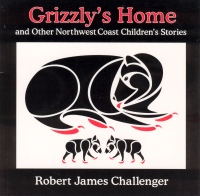| ________________
CM . . .
. Volume XII Number 10 . . . .January 20, 2006
excerpt:
In Grizzly's Home and Other Northwest Coast Children's Stories, the sixth in a series of conversational, easy-to-read, engaging, and entertaining contemporary fables by British Columbia author-illustrator Robert James Challenger, Grizzly Bear, Octopus, and Raven learn about such timeless values as respect, cooperation, and kindness. These characters also show in an uncomplicated way that in the complicated world around us, there are moral lessons to be learned from nature. Told in a storytelling fashion which resembles First Nations oral tradition, the 18 one-to-two-page stories explore a range of complex issues and challenging concerns (single-parent families, abuse, the environment, leadership, physical differences, jealousy, and dishonesty) that may confront today's children at home, at school, or on the playground. Challenger's characters, who address these issues through "personal" experience and example, do not have formal names. They are both human (Grandfather, Grandmother, Grandson, or Granddaughter) and non-human (Grizzly Bear, Kingfisher, Ant, Little Mink, Spider, Raven, Little Bobcat, Mother Quail, Weasel, Butterfly, Octopus, Skunk, Steelhead, Duck, Heron, Owl, Mountain Sheep and Dogwood). In each fable, a grandparent tries to help a troubled grandchild find answers to a problem by telling him or her a story about a lesson learned by a non-human friend from nature who had a similar problem. In "Mother Quail's Chicks," Mother Quail helps the Quail chicks to understand that, although Father Quail has left and now lives on the other side of the big meadow, they are still loved by both parents and that, in spite of this upheaval, their single-parent family can be a happy one. In "Weasel's Trap," Grandson finds out that it takes courage to tell the truth. He learns from Weasel, who had made things worse by telling a second lie to cover up the first, that lying creates a trap in which you always get caught. In "Heron's Rule," Grandson struggles to keep a secret his friend has told him not to tell; his friend was being "hurt by a grown-up." Grandson learns from Grandfather's story about Heron's rule about keeping secrets that he should listen to the voice inside him to do the right thing and that it is better to have the courage to break the promise and risk losing his friend than it is to see his friend continue getting hurt. In "Duck's Discovery," Granddaughter's school year has come to an end for summer vacation, and, as she thinks ahead to the fall, she becomes upset at the thought of a new class, a new teacher, and new friends. Grandfather's story of Little Mallard Duck who was in a similar situation helps her come to terms with this uncontrollable change in her life. Little Mallard Duck refused to go south with his family for the winter because he did not want to leave his friends and familiar surroundings. He was left behind for the winter, and, lonely, cold, and hungry, he came to the realization that change is inevitable and you have to accept it even when you think you are not ready. Challenger's stories take place in natural surroundings familiar to children - around a campfire, on a forest trail, in a neighbourhood yard, on a beach, in a meadow, in a tree, on the shores of lakes, creeks and ponds, in the air and even on the bottom of the sea. He creates his scenes at the beginning of each fable with vivid, clear, and alluring descriptions that invite and draw not only the characters into the storytelling and lesson to be learned but the readers as well. Here are two examples:
Just as each story's message is simple and clear, so is the layout of the book. There is no clutter, lots of white space, and clean bold type for easy reading. For perusal and future reference, a Table of Contents lists the 18 short story titles and their appropriate pages. An attractive soft, glossy cover with an illustration of Grizzly Bear and her cubs has definite pick-up and open-the-book appeal. The back cover, which features an annotation of the fables between the covers, is decorated by vignettes of two characters from the book, Kingfisher and Steelhead. The "icing on the cake" for this book is Challenger's Haida-style full-page form-line black, white and red artwork. Framed in a continuous storytelling circle, each character who is the focus of the story (an animal, bird or fish), is featured in the centre of each circle. Challenger masterfully uses line to convey energy and movement. No image is static. Limbs are in full motion; wings are in full flight; fins are in full propulsion. Each illustration invites artistic exploration. For those wanting to find out more about Robert James Challenger, his prose, his art, and his passion for "absorbing all the stories the Northwest Coast has to offer," at the end of the book there is a one-page note, "About the Author" that also includes his photograph and his website. The final sentence best sums up Challenger's work: "Jim's stories and designs bring a unique perspective to how we can learn from nature's examples in the world that surrounds us."
Recommended. Lois Brymer is a recent graduate of the University of British Columbia's Master of Arts in Children's Literature Program.
To comment
on this title or this review, send mail to cm@umanitoba.ca.
Copyright © the Manitoba Library Association. Reproduction for personal
use is permitted only if this copyright notice is maintained. Any
other reproduction is prohibited without permission.
NEXT REVIEW |
TABLE OF CONTENTS FOR THIS ISSUE
- January 20, 2006.
AUTHORS |
TITLES |
MEDIA REVIEWS |
PROFILES |
BACK ISSUES |
SEARCH |
CMARCHIVE |
HOME |

 Grizzly's Home and Other Northwest Coast Children's Stories, which lends itself to post-reading discussion, would be an excellent resource for parents, teachers, and caregivers to use in a nonthreatening way to address issues that may be foremost on children's minds. Challenger's stories subtly demonstrate to young people that it is okay to share feelings with a grown-up. As well, this book would have several applications in the Grade 3 to 6 classroom, particularly in art classes to illustrate examples of the Northwest Haida art style and in science classes to complement a study of animals of the Northwest.
Grizzly's Home and Other Northwest Coast Children's Stories, which lends itself to post-reading discussion, would be an excellent resource for parents, teachers, and caregivers to use in a nonthreatening way to address issues that may be foremost on children's minds. Challenger's stories subtly demonstrate to young people that it is okay to share feelings with a grown-up. As well, this book would have several applications in the Grade 3 to 6 classroom, particularly in art classes to illustrate examples of the Northwest Haida art style and in science classes to complement a study of animals of the Northwest.